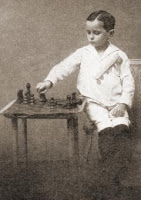Review by JOSIAH JONES
"It's Halloween! It's Halloween!
The moon is full and bright
And we shall see what can't be seen
On any other night"
—"It's Halloween", P. 7
The title poem starts us off with a lyrical overview of Halloween's delightfully atmospheric thrills. The night's unique ambience is part of why trick-or-treating is such fun. "The Skeleton Parade" is next, all clacking, clinking bones as a troupe of skeletons walks out in the open as they cannot do on any other day. We then read "The Tricksters", a ballad of three clever kids dressed as a witch, a skeleton, and a ghost, who love Halloween for the opportunities it presents to play minor tricks on others. The story is enhanced by Marylin Hafner's evocative renderings of Halloween night.
'Pumpkin" follows three kids who buy a pumpkin, take it home, and carve it into a grinning jack-o'-lantern illuminated by a candle within. Designing a creative jack-o'-lantern is one sure way to get into the spooky spirit of the holiday. "Countdown" builds to a jump scare as a girl holding her cat keeps track of where all the ghosts in the house are, including one sneaking up behind her... "Countdown" is reminiscent of a lot of scary American folklore.
In "Trick...", a group of kids who approach a house in costume to collect candy are chased away by the mean couple who live there. The kids exact payback with a few traditional pranks—soaping the windows and chalking their door—and maybe the couple will think twice about being rude next Halloween.
"There's a goblin as green
As a goblin can be
Who is sitting outside
And is waiting for me.
When he knocked on my door
And said softly, "Come play!"
I answered, "No thank you,
Now please, go away!"
But the goblin as green
As a goblin can be
Is still sitting outside
And is waiting for me."
—"The Goblin", PP. 33-35
"The Goblin" is the eeriest, most unsettling selection from this book, and the illustrations account for a lot of that. The kid feels pursued by the goblin without the horned creature moving an inch from its perch in the tree outside his window. The kid rebuffs the goblin's soft-spoken invitation to come out and play, but the beast just sits and stares in response, waiting. Goblins will wait as long as necessary to catch us if we wander outside without regard for the danger they pose, and this poem reminds us of that. It's a highly effective piece. "...or Treat" isn't a direct continuation of "Trick...", the poem before "The Goblin". It's a goodnatured verse about trick-or-treating door-to-door, promising to pull pranks if the people inside don't come through with candy. All in good fun.
"Bobbing for Apples" frames a kid's frustrating lack of success in the title game, even as the kid's sister has no problem fishing an apple out of the water using only her teeth. It is a challenging game, and some take to it better than others. "Haunted House" is another atmospheric poem, about a house on a hill that every kid knows is inhabited by goblins, ghosts, and witches. The monsters congregate inside for their own holiday celebration on October 31, and kids know better to join them if invited. Nothing good happens at a gathering of ghoulish fiends. "Black Cat" shows a stealthy feline pattering around after dark, and a boy who sees it and runs away. He needn't court bad luck by getting too close.
"Ghost" is a fun scare shared by a pair of friends, and "Happy Halloween" brings the collection to an end with the same trio from "The Tricksters" as they return home after a night of trick-or-treating, feeling full and satisfied and ready to fall asleep and dream of their happy Halloween. It's a nice final poem.
There are numerous good selections here, but "The Goblin" is best of the lot, a scary little verse with some depth. When a goblin appears at your window and asks you to play, will you agree to its request? Refusal doesn't mean you're safe forever. The monster will always be there waiting if your resolve wavers and you decide to dabble in its forbidden games. Jack Prelutsky is a reliably thoughtful writer, and "The Goblin" is his most intriguing poem in this book. It's Halloween is an entertaining collection; Prelutsky's fans won't be disappointed. Few do juvenile poetry better than he.
____________________________________________________________
JOSIAH JONES is an avid writer who has loved books for as long as he has been able to read them. Among his favorite authors are Louisa May Alcott, Rachel Field, Joseph Krumgold, Irene Hunt, E. L. Konigsburg, Katherine Paterson, Barbara Park, Jerry Spinelli, Edward Packard, R. L. Stine, and Neal Shusterman. In addition to writing and reviewing, Josiah has been a competitive juggler on the international stage, traveling as far as the United Kingdom and Canada. He is a free speech absolutist and a passionate fan of classic television and almost every variety of sport, from the popular to the obscure.







